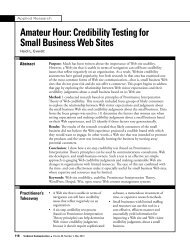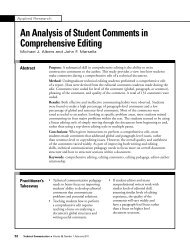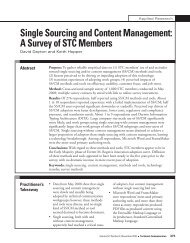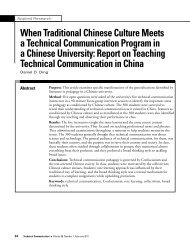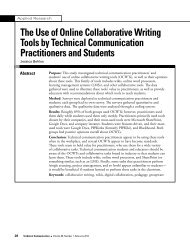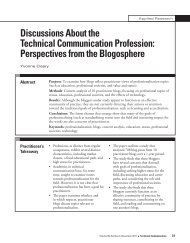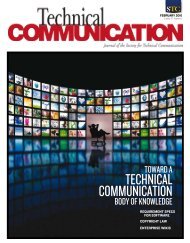Book Reviewsand direction for development. If you’re looking forinformation on user interfaces other than the traditionalGUI, this book is a great place to start.Devor BartonDevor Barton holds a BA in communications from the Universityof Houston, and a certificate of project management and an MSin technical communication from the University of Washington.He is a member of STC’s Puget Sound Chapter and the TechnicalEditing SIG, and is an ICIA Certified Technology Specialist.Artifice and Design: Art and Technology inHuman ExperienceBarry Allen. 2008. Ithaca, NY: Cornell University Press. [ISBN 978-0-8014-4682-5. 213 pages, including notes and index. US$35.00.]Barry Allen’s Artifice and Designargues that the invention oftools established a commonground between design(technology) and artifice (art).For Allen, only humans caninfer the intentions of others(whether expressed or not),and this awareness definesa uniquely human socialunderstanding. The singulardexterity of the human handcan in turn shape this socially shared knowledge intofunctional objects, tools, and artifacts. Human toolsare therefore consciously “designed and made, usually byothers, to facilitate action”; they are “manufactured,”literally “made by hand,” and are specifically socialin nature (p. 2). In contrast, apes lack both the abilityto read intentions and the prehensile facility tomanufacture tools. A chimp extracting termites from ahole with a stick employs “a conveniently nonce objectmanipulated into facilitation,” but such use dependsentirely on the co-presence of stick, ape, and termites(p. 2). A chimp will not necessarily use his “proto-tool”again, even in the same circumstance; nor will he see itsusefulness in other situations or share his knowledgeof it; hence a chimp’s tool is really a “proto-tool,” animplement usable only in a particular context, andusually only once.Tools and artifacts—made objects—thereforeembody the social needs and purposes of the group;these include both utility and beauty. Hence artifacts aredesigned for both function and perception, either singlyor as assembled systems. The emergence of artifactualsystems combining instrumentality with aestheticsresults in what Allen calls “technology” and coincideswith the development of art—both involve artifactsdesigned “in anticipation of perception” (p. 177); bothare unified in a “technical economy” of “perceptuallyexpressive works” (p. 157); and since “technicalcoherence (design) begins with aesthetic coherence(beauty) and never abandons it,” both share a commonorigin and retain a symbiotic relationship (p. 178).New York’s Hell Gate Bridge exemplifies thissymbiosis. The arch bridge, its ends embedded on eachside of the East River, can easily support its load allby itself, yet the designer added massive towers at theabutments. Why include towers that aren’t technicallynecessary? Because both the engineer’s “trained” eyeand the nonengineer’s untrained eye feel “the want ofa visual counterpart to the thrust inconspicuouslychanneled into the foundations” (p. 139). Intellectually,we understand the bridge’s ability to work withoutthe towers; aesthetically, we do not. We need to see theweight at work; and so an aesthetic quality is built intothe object in anticipation of its perception. However,though they seem purely ornamental, the towers, byincreasing downward thrust, also assume a functionalpurpose: they permit “the designer to minimize thevolume of the foundation while keeping thrusts withinthe safety zone” (p. 140). Beauty and utility, then, are notmutually exclusive. They reinforce each other, and thiscan be seen throughout history, in an ancient axe or amodern bridge.Allen’s argument sometimes seems circular andrepetitive, and the style occasionally is obscure, butthese are cavils. The book is rich in insight, revealsdeep scholarship, and will provoke fruitful reflection intechnical communicators concerned about usability as acombination of utility and beauty. Read it!Donald R. RiccominiDonald R. Riccomini is an STC member and a lecturer in Englishat Santa Clara University, where he specializes in teachingengineering and technical communications. He previouslyspent 23 years as a technical writer, engineer, and manager insemiconductors, instrumentation, and server development.336 Technical Communication l Volume 57, Number 3, August 2010
Book ReviewsOrigins of the Specious: Myths andMisconceptions of the English LanguagePatricia T. O’Conner and Stewart Kellerman. 2009. New York, NY: RandomHouse, Inc. [ISBN 978-1-4000-6660-5. 266 pages, including index.US$22.00.]Who hasn’t had a viciousargument about the properuse of a word or whetherEnglish is a malleablelanguage? Maybe that’s justme. But if language is yourgame, Origins of the Specious:Myths and Misconceptions ofthe English Language is yourbook. It’s a blooper highlightsreel of English, explainingfables from the mythabout the number of Eskimo words for snow to themisconception that all double negatives are incorrect.Origins of the Specious discusses these misuses andmyths with a wry sense of humor. It even includessome lightly dirty humor, such as a bit of history on theYiddish word putz. When discussing that newspaperswere “abuzz” about two Oxford dictionaries givingthe okay to willy-nilly split your infinitives, theauthors comment, “It was a slow news week” (p. 17).In explanation for why the word ain’t is no longerconsidered acceptable language, they say, it “got too bigfor its britches” (p. 49). An entire chapter that had mesnickering is “Lex education: Cleaning up dirty words.”If you want to bore the curse words out of unrulychildren (or inform it out of them, depending on theirdisposition), you might read them this chapter.The authors use humor to get a basic idea across:English is a liquid language (regardless of how thickwe would like that liquid to be). Throughout the book,they say that English is changed by “the people whoactually use the language day in and day out” (p. 43), thatis, all of us. My favorite example is the hunt for a single“all-purpose pronoun for people that can be masculineor feminine” (p. 141). We all know how frustrating it isto write around “he/she” and “he or she.” But try aswe might, no word has successfully taken hold of thisempty space. Thon made a valiant effort in 1858 but fellby the wayside. Regardless, it will always hold a specialplace in my heart.Occasionally, their humor can get a bit harsh, but ina teasing way. With regard to the literal meaning of “begthe question,” which Aristotle originally used in 350 BC,they say, “It’s time for the purists to get a life—one inthe twenty-first century” (p. 182). In another exampleof harsh but humorous reprimands, they say, “If youthink ‘octopi’ is classier than ‘octopuses,’ go stand in thecorner” (p. 184). Away I went.At times, this book had me laughing out loud forthe dorky language jokes. And if it doesn’t provideenough information for you, the bibliography inthe back provides 30 other resources. I definitelyrecommend Origins of the Specious for language junkieswith a good sense of humor.Angela BoyleAngela Boyle is a technical writer for Tyler Technologies, Inc,where she has worked for four years. She graduated from theUniversity of Washington with a BS in technical communication.Writing Up Qualitative ResearchHarry F. Wolcott. 2009. 3rd ed. Thousand Oaks, CA: Sage. [ISBN 978-1-4129-7011-2. 208 pages, including index. US$41.95 (softcover).]Ironically, when I beganreading Writing Up QualitativeResearch, I was in the midstof writing an article thatwas attached to a swiftlyapproaching deadline. Iknew the material, but Ijust couldn’t seem to put ittogether in a way that I feltwould engage the audience.Few academics out therehaven’t been confrontedwith a similar scenario, which is why this book is sonecessary. Harry F. Wolcott, a professor emeritus at theUniversity of Oregon, has been through the trenchesin his 40-plus years as an academic, and his advice isboth comforting and valuable for any academic writerwho works with qualitative data.Writing Up Qualitative Research is organized into sevenchapters that mirror the writing process. Wolcott beginswith a discussion of getting started with your writingVolume 57, Number 3, August 2010 l Technical Communication 337
- Page 1 and 2:
AUGUST 2010Volume 57 Number 3SPECIA
- Page 3 and 4:
PresidentMichael A. HughesVice Pres
- Page 5 and 6:
VoLuME 57, NuMBER 3AUGUST 2010ISSN
- Page 7 and 8:
Guest EditorialKirk St.Amant and Ma
- Page 9 and 10:
Applied ResearchTechnical Communica
- Page 11 and 12:
Applied ResearchNicole St. Germaine
- Page 13 and 14:
Applied ResearchNicole St. Germaine
- Page 15 and 16:
Applied ResearchNicole St. Germaine
- Page 17 and 18:
Applied ResearchNicole St. Germaine
- Page 19 and 20:
Applied ResearchNicole St. Germaine
- Page 21 and 22:
Applied ResearchNicole St. Germaine
- Page 23 and 24:
Applied ResearchNicole St. Germaine
- Page 25 and 26:
Applied TheoryTatiana BatovaIntrodu
- Page 27 and 28:
Applied TheoryTatiana BatovaMoreno,
- Page 29 and 30:
Applied TheoryTatiana BatovaThe Uni
- Page 31 and 32:
Applied TheoryTatiana Batovadoctors
- Page 33 and 34:
Applied TheoryTatiana BatovaTo addr
- Page 35 and 36:
Applied TheoryTatiana Batovathe loc
- Page 37 and 38:
Applied TheoryTatiana BatovaJohnson
- Page 39 and 40:
Applied TheoryTatiana BatovaInterna
- Page 41 and 42:
Applied TheoryMcKee and PorterIntro
- Page 43 and 44: Applied TheoryMcKee and PorterFor e
- Page 45 and 46: Applied TheoryMcKee and Porterpubli
- Page 47 and 48: Applied TheoryMcKee and PorterBecau
- Page 49 and 50: Applied TheoryMcKee and Porterof th
- Page 51 and 52: Applied TheoryMcKee and Porterwith
- Page 53 and 54: Applied TheoryMcKee and PorterA Cop
- Page 55 and 56: Applied TheoryMcKee and PorterConte
- Page 57 and 58: Applied TheoryMcKee and PorterWalto
- Page 59 and 60: Applied ResearchLiza PottsIntroduct
- Page 61 and 62: Applied ResearchLiza Pottsdoes not
- Page 63 and 64: Applied ResearchLiza PottsUser’s
- Page 65 and 66: Applied ResearchLiza Pottsactors, t
- Page 67 and 68: Applied ResearchLiza PottsDRM has a
- Page 69 and 70: Applied ResearchLiza Pottsmake bett
- Page 71 and 72: Applied ResearchLiza PottsOne viewe
- Page 73 and 74: Applied ResearchLiza Pottsinvolved
- Page 75 and 76: Applied ResearchLiza PottsHayhoe, G
- Page 77 and 78: Applied ResearchInternational Fair
- Page 79 and 80: Applied ResearchTyAnna K. Herringto
- Page 81 and 82: Applied ResearchTyAnna K. Herringto
- Page 83 and 84: Applied ResearchTyAnna K. Herringto
- Page 85 and 86: Applied ResearchTyAnna K. Herringto
- Page 87 and 88: Applied ResearchTyAnna K. Herringto
- Page 89 and 90: Book ReviewsWriting Successful Scie
- Page 91 and 92: Book ReviewsThe Process: Business P
- Page 93: Book ReviewsHCI Beyond the GUI: Des
- Page 97 and 98: Book Reviewsgenre, and process, top
- Page 99 and 100: Book ReviewsPart One goes from the
- Page 101 and 102: Book Reviewsrather than writers, an
- Page 103 and 104: Book ReviewsHow to Write Fast Under
- Page 105 and 106: Book Reviewsmanagement system (CMS)
- Page 107 and 108: Book Reviewsnearly strangled when h
- Page 109 and 110: Book Reviewsinteractive TV model)
- Page 111 and 112: Book ReviewsOtherwise, Beech shows
- Page 113 and 114: Book Reviewssuch as blog, I found m
- Page 115 and 116: Book Reviewsemployees and effective
- Page 117 and 118: Recent & RelevantSherry Southard, E
- Page 119 and 120: Recent & RelevantRecent & RelevantC
- Page 121 and 122: Recent & RelevantRecent & RelevantE
- Page 123 and 124: Recent & Relevantworking in a langu
- Page 125 and 126: Recent & RelevantWhat’s the big d
- Page 127 and 128: Recent & RelevantScientific Writing
- Page 129 and 130: Recent & Relevantapplicability. Man
- Page 131: Did You Missthe Summit?Don’t miss



